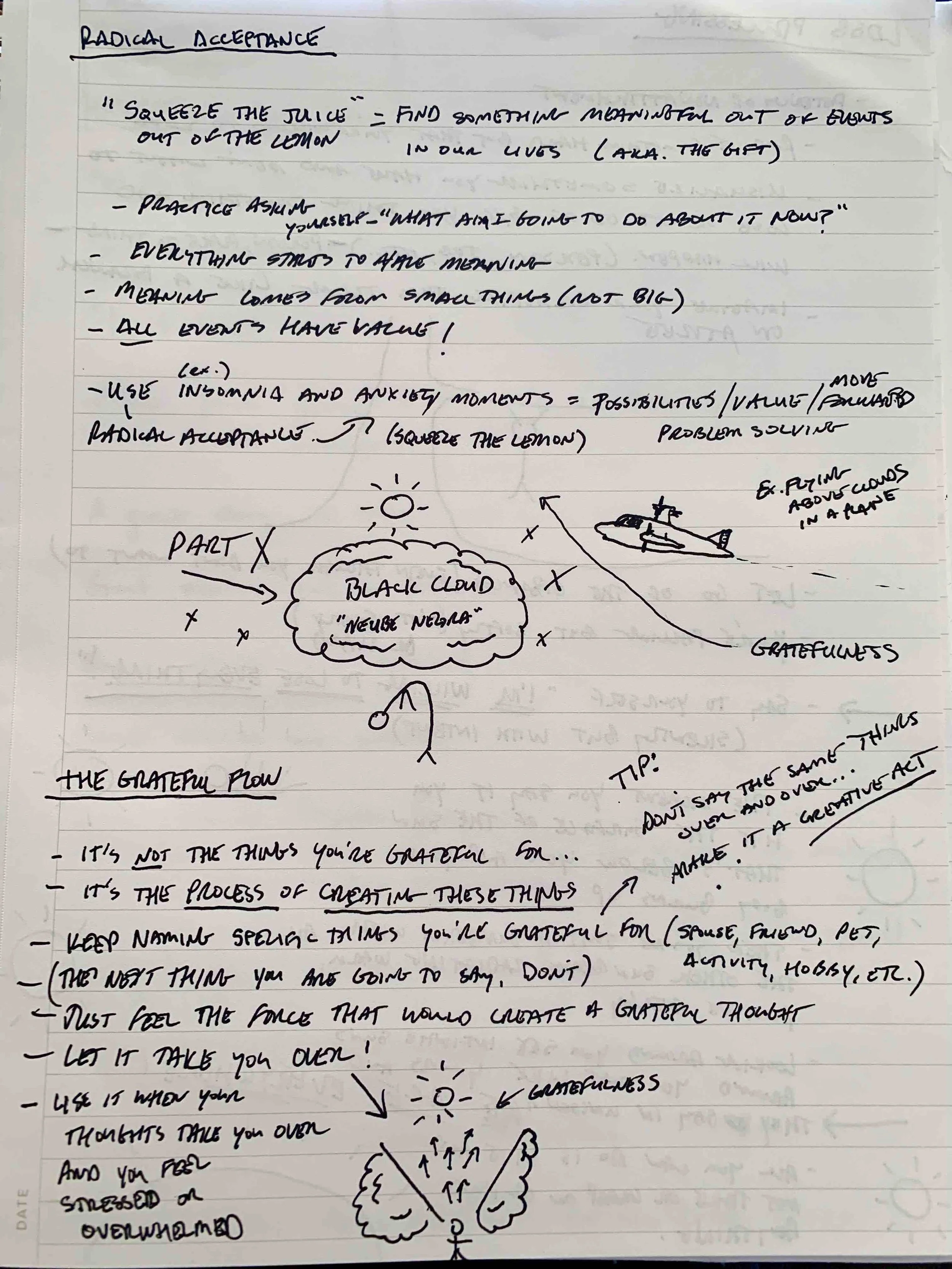Work on Your Acceptance
Last week I continued sharing insights from “Stutz”, the recent documentary by Jonah Hill on Netflix. I started with Part X, the villain in our story. Then I broke down some of the tools that Phil Stutz, Hill’s therapist, uses to help Jonah and others on their journey in life, like The Snapshot, The Maze, and The Shadow. This week I’m going to share the final set of tools Stutz provides that focus predominantly on acceptance as well as some visual exercises you can use to break out of overwhelm, get into a flow, and even process loss.
RADICAL ACCEPTANCE
One of the frameworks I use when coaching people involves acceptance. The cycle starts with awareness, then comes acceptance, and finally action. Then you rinse and repeat. We must first have a conscious awareness that something is happening or needs to change. Until we are aware of the thing, there is not a clearly defined way forward. For example, if you don’t know that you have ADHD, then you don’t know why you have trouble focusing on tasks or learning as others do. If you don’t know that you are a person that thinks out loud or “talks to think”, then you can’t share that with others so they know that’s how you best process thoughts and ideas. This is especially helpful when interacting with people who “think to talk”, like my wife. Once we discovered the difference between how each of us processes things we were able to find common ground in our conversations. Once there is awareness then comes acceptance, we must accept the situation, we are actually in now (not the one we wish we were in), and then understand where we want to be. After we have accepted where we are and know where we are headed, we can go into action. Stutz shares some great insights around radical acceptance and how to take action when events occur and you become aware of the uncomfortable situation you are in.
First, he talks about “squeezing the juice out of the lemon”. Find something meaningful out of events in your life, or what I call “the gift”. I like to ask “What is the gift in this situation?” Stutz invites us to ask ourselves, “What am I going to do about it now?” When you have this perspective, everything starts to have meaning. Meaning comes from small things (not big ones). All events have value if we take the time to explore their meaning and purpose. Sometimes it won’t show itself right away. Sometimes it might be because we haven’t learned the lesson we were meant to learn yet. Stutz gives an example of insomnia and anxiety and says that they actually equate to possibilities, value, moving forward, and problem-solving. Essentially, radical acceptance is squeezing the juice of the lemon in our life and getting all the value we can from it. He uses a powerful example of a plane flying below a vast, never-ending stretch of clouds and how it can feel dark and ominous underneath them. Once the plane climbs up through the clouds suddenly you see the warm, bright sun in all its beautiful glory. He then transitions to how this applies to us. He references Part X and how our villain will bombard us with negative thoughts and judgments giving us the same sense of a black cloud overhead that we can’t seem to break through. Even though the sun is just above our own thick, heavy cloud, it can feel like we will never push through it and catch a break. Well, the next tool he provides is the simple method we can use to break through our black cloud.
THE GRATEFUL FLOW
When I do my morning mantra to prime myself for my day I start with “Thank you. I’m grateful for the ability to breathe in another glorious day and to breathe out love and light into the world…” I’ve felt the power of gratitude in my life and know many others that share the same sentiment. Sometimes that practice of gratitude might not be enough. Stutz shares a tool, called The Grateful Flow, to practice regularly that takes the idea of gratitude further. He posits that it’s not the things you’re grateful for…it’s the process of creating these things. He says to keep naming specific things you’re grateful for, like your spouse, friend, pet, activity, hobby, etc. One thing to note: Don’t say the same things over and over. Make it a creative act where you continue to find new things you are grateful for. After you’ve said a few things and are about to say the next thing you’re grateful for — don’t. Stop just before you are about to say it. Just feel the force that would create that next grateful thought. Let it take you over. Use that force when your thoughts take you over and you feel stressed or overwhelmed. That intentional gratefulness is what allows us to break through our black cloud and the negative thoughts our Part X is overwhelming us with. Gratefulness is our way of flying above the clouds just like the plane he shared in his example.
LOSS PROCESSING
Finally, Stutz provides a powerful tool to help with processing loss. He talks about the potency of non-attachment. He says to pursue something hard but that you’re willing to lose. Visualize something you have and don’t want to lose or let go of because you think something bad will happen. This could be a person, pet, job, home, etc. Imagine you’re grasping this “thing” like a branch on a tree. Then, let go of the branch — even though you don’t want to. Visualize yourself falling but softly not scary or hard. Say to yourself silently but with intent, “I’M WILLING TO LOSE EVERYTHING!” The moment you say it you hit the surface of the sun below you and your body burns up. Then you’re just a sunbeam with all the other sunbeams radiating with warm, positive energy. Looking around you see infinite suns surrounding you just like yours and they all say in unison, “WE ARE EVERYWHERE!” All you can do is give and not take or grasp on or hold anything because you are a bright, beautiful sunbeam shining out with all the others around you.
For those of you that have been following my journey, you know that I had a significant loss in late 2020 when my dad passed away from stage 4 lung cancer. We’ve all felt the sting of loss in some shape or form, especially over the last few years. This is something we all must face as human beings. It’s tools like these allow us to arm ourselves so we are not at the mercy of our Part X. While watching the documentary, I not only took notes on these amazing tools and insights, but I also did the exercises along with him and Jonah Hill. During this section of the doc, I actually stopped and did this exercise twice. First, I thought about my partner, who I care deeply for, and had to leave for several months while caring for my dad. I felt what it was like to be away from her after being together for over ten years. She is my soul mate, best friend, lover, and partner. Our life together as humans has an inevitable expiration date though. During the second visualization, I thought about my business, Ärtful, which I created and have been committed to for six years. It is very much like my baby and needs many of the same elements of support, encouragement, and growth. Similarly, my business will not last forever. The sense I got from both visualization exercises was about empowerment, acceptance, and peace. As Stutz points out and I shared previously, there are three constants in life: pain, uncertainty, and work. Having the awareness that we will feel pain, we will constantly deal with uncertainties and will work until we can longer, provides a gateway to freedom and a sense of peace. Tools like this allow us to visualize a positive experience around loss that is on our own terms and gives us the power to process the inevitability of loss and another constant in life — change. We, just like all things in life, are in a constant state of change whether we like it or not.
I hope that these few pieces I’ve shared help you on your journey in business and life and that the tools Stutz and Hill share in their documentary can support you as you walk your path with grace. My invitation to you is to try these tools and visualizations out and explore how they can help you. I’m interested to see what comes up for me as I continue to explore them myself. Feel free to DM me directly or keep the conversation going online.


